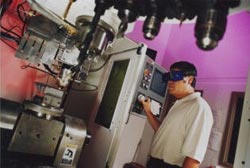Researchers Study Ways to Make Stronger Materials in 3-D

Missouri S&T photo<br><br>Dr. Frank Liou observes the metal deposition process in the Laser Aided Manufacturing Process (LAMP) Laboratory at Missouri University of Science and Technology.<br>
The Missouri S&T researchers also plan to fabricate some of these new materials soon, says Dr. Frank Liou, director of the university’s Laser Aided Manufacturing Process (LAMP) Laboratory and the Michael and Joyce Bytnar Professor of Product Innovation and Creativity.
For the past 15 years, Liou and his colleagues have been developing a fabrication method known as additive manufacturing. The process involves the use of high-powered lasers to melt small particles of powdered materials as they exit a nozzle to create three-dimensional shapes, layer by layer. The technique is similar to 3-D printing, which has grown in popularity in recent years.
According to Liou, the additive approach applies to a broad range of manufacturing – from the fabrication of large aircraft components to minuscule biomaterials used in surgical procedures. Some of Liou’s students who enjoy fishing even joke about using LAMP’s additive manufacturing tools to make a canoe, layer by layer.
Additive manufacturing approaches result in a denser, stronger material than conventional methods, such as milling, machining or forging of metals. Liou, who also directs Missouri S&T’s manufacturing engineering program, says steel parts made using the additive method are 10 percent stronger than steel that is machined.
In his latest research, Liou is combining additive manufacturing with more conventional approaches to creating materials. He calls the approach “hybrid manufacturing.”
With hybrid manufacturing, S&T researchers could apply an additive manufacturing technique to create aircraft components from two different metals – perhaps steel and copper – and then smooth the parts’ rough edges using automated computer-numerical control machining.
Liou has received about $660,000 from NASA to develop computer models of various additive manufacturing approaches. He believes the models will lead to a greater understanding of how layered materials adhere, or bond, to the surface on which they are deposited.
“In many aerospace or biomedical applications, you cannot afford metal fatigue,” or cracking of the material, Liou says. “It is important to understand how well a deposited metal bonds to the surface.”
Liou recently received another $750,000 from NASA to support the next step of this research: the fabrication of new materials not generally observed in nature. The research could lead to stronger metals as well as a way to repair expensive components instead of scrapping them, Liou says.
“Some dies or molds could cost a quarter of a million dollars to replace,” Liou says.
Media Contact
More Information:
http://www.mst.eduAll latest news from the category: Materials Sciences
Materials management deals with the research, development, manufacturing and processing of raw and industrial materials. Key aspects here are biological and medical issues, which play an increasingly important role in this field.
innovations-report offers in-depth articles related to the development and application of materials and the structure and properties of new materials.
Newest articles

Machine learning algorithm reveals long-theorized glass phase in crystal
Scientists have found evidence of an elusive, glassy phase of matter that emerges when a crystal’s perfect internal pattern is disrupted. X-ray technology and machine learning converge to shed light…

Mapping plant functional diversity from space
HKU ecologists revolutionize ecosystem monitoring with novel field-satellite integration. An international team of researchers, led by Professor Jin WU from the School of Biological Sciences at The University of Hong…

Inverters with constant full load capability
…enable an increase in the performance of electric drives. Overheating components significantly limit the performance of drivetrains in electric vehicles. Inverters in particular are subject to a high thermal load,…





















